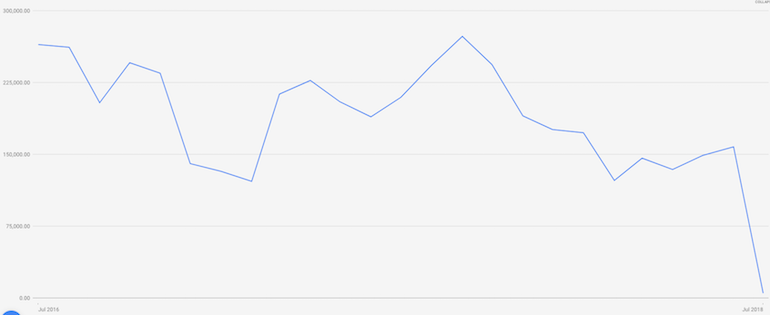You may have a client, or you may be a client, asking the question, should we spend more on branded or non-branded terms? Like anything in PPC, it depends on the industry, the type of product/service, what your competitors are doing, how your PPC account is currently set up, etc. Having worked with a variety of clients, I have seen a wide range of strategies. Two opposing examples: a CEO for a large ecommerce company did not see the value of bidding on branded terms, while another ecommerce client decided to bid exclusively on branded terms.
Whether you are a lead generation or ecommerce business, a successful PPC strategy is one that includes non-branded campaigns. Throughout this blog I will provide examples of how non-branded campaigns increase traffic to your site, capture new customers, build brand loyalty, and beat the competition.
Increase Traffic to Your Site
Generating new customers is the primary reason every PPC strategy should incorporate non-branded campaigns. To illustrate this point, let’s use a general example: sandals.
“Birkenstock sandals” (branded keyword) will be searched 135k times over a one month period. “Sandals”(non-branded keyword), averages 301k queries per month. Do you think Birkenstock’s PPC strategy should include non-branded keywords? Absolutely! Clearly, non-branded terms garner more traffic, but let’s talk about how to leverage non-branded keywords most effectively.

As you can see in the above screenshot, CPCs are going to be high with non-branded terms. Depending on your industry and brand recognition, you will need to be selective when choosing which non-branded keywords to include in your campaigns. For example, targeting “leather sandals”, instead of “sandals”, would be a better decision. Highly competitive keywords that are not specific enough to your product/service will drain your budget. Non-branded keywords are top-of-funnel terms so EXPECT to see lower conversions rates and higher CPLs.
Setting up RLSA (Remarketing Lists for Search Ads) will also help you have a more full funnel approach. Check out this blog to learn more about RLSA.
The Importance of Brand Loyalty
Brand loyalty has a major impact on revenue. According to Accenture, “If a consumer is loyal to your business, he or she will spend an average of 66% more than customers who aren’t loyal.”
Non-branded campaigns are an excellent way to reach customers that otherwise would not have entered your market funnel. While this may be obvious, not every client we work with understands how to bring in new customers. In a lot of cases, businesses either don’t understand, or don’t see the value of how non-branded campaigns can be a primary channel to reach new customers.
When executed correctly, launching non-branded campaigns will increase the rate at which your customer base grows, resulting in more opportunity to create loyal customers. Based off of Accenture’s consumer report, this could lead to a 66% increase in the average LTV (lifetime value).
Again, running a RLSA Non-Branded campaign will play a crucial role in retaining current customers. Don’t let your customers research for your competitors without seeing an ad with specific messaging that is relevant to them or that is offering a new deal.
Now let’s walk through how non-branded campaigns actually bring in new customers.
Reach New Customers
Businesses need to attract new customers to stay alive. I’ve experienced the importance of reaching new customers with an ecomm client who has seen a 13% YoY decrease in new customer reach. There are a two primary reasons the client has experienced this decline:
- Branded Impression Share: The client has 80% impression share on branded terms. The other 20% is all resellers. What does this mean? The client doesn’t have any competition and they have maxed out their reach on branded terms. In addition to the decrease in new users, their branded ROAS (return on ad spend) has also fallen over the past two years.

- No Non-Branded Campaigns: The second reason is the whole point of this blog post: they only had branded campaigns running during this two year period. The client needs new avenues to generate new users in order to increase revenue.
So how do we know running non-branded campaigns will help? Hanapin has managed countless clients that have seen considerable return from non-branded campaigns. Recently, we had a client who was struggling to attract new customers. This client was also exclusively targeting branded terms. Within two months of managing the account, our team launched a non-branded campaign in Bing and subsequently saw new customers rise by 289% MoM and 210% YoY.
Discovering new search terms is one byproduct of bidding on non-branded terms. All it takes is one search term to expand your reach and bring in more new customers.
Beat the Competition
Bidding on non-branded terms is key to beating your competition. The logic is similar to why bidding on branded terms is necessary – you don’t want your competition stealing customers because you aren’t willing to spend money on your branded terms, even if you have great brand awareness. Similarly, your competition is going to bid on non-branded terms. If you don’t bid on relevant non-branded terms, not only are you losing out on potential customers, you are letting new customers walk right through the doors of the competition.
Conclusion
If you are going to reach new customers, and see your business expand, non-branded campaigns are crucial to your PPC strategy. If you currently aren’t running any non-branded campaigns, open up Google’s keyword planner and get started today!



